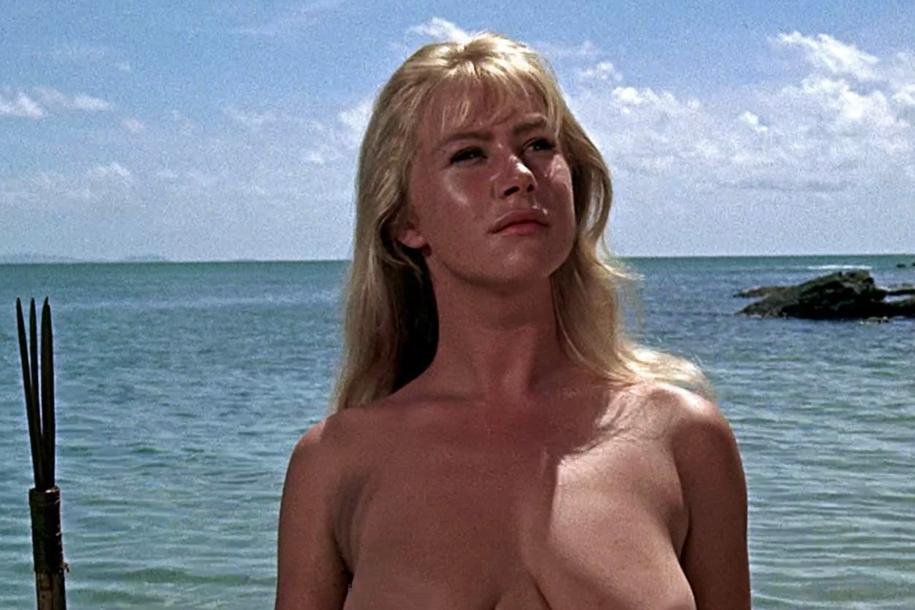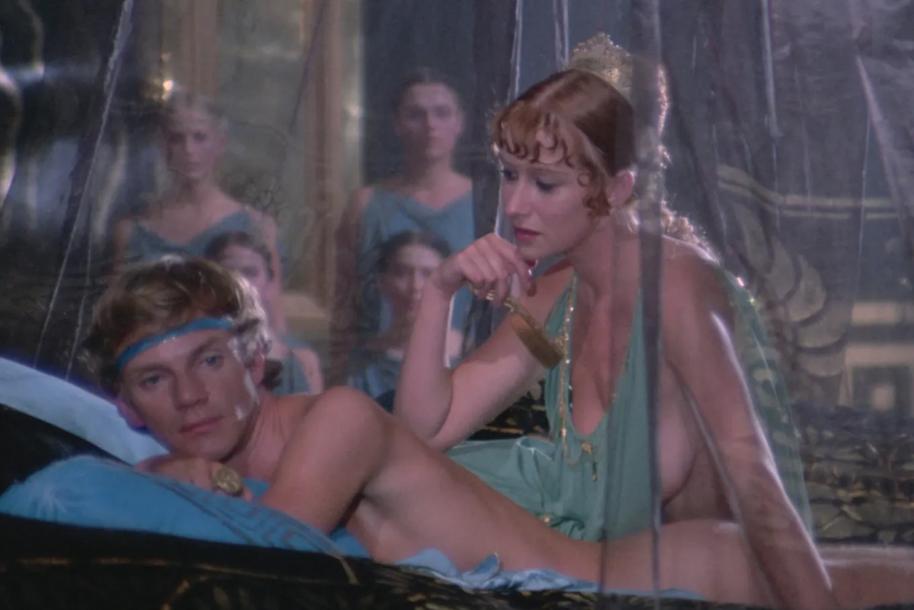More On:
porn
-
‘Boy Meets World’ Podcast Turns Tense As Danielle “Topanga” Fishel Spars With Former Co-Star Turned Porn Star Maitland Ward
-
Stream It Or Skip It: ‘X-Rated Queen’ on Max, a Polish Series About a Porn Star’s Rise to Infamy
-
A Thing Not To Do: Lily Phillips Breaks Down In Tears After She “Sleeps With” 100 Men in One Day
-
The Problematics: ‘Body Double’ at 40, Drilling Down On Brian De Palma’s Most Brutal (And Misogynist?) Murderfest
Bob Guccione, the American-born would-be fine artist who, after years of not making it Jerry-Mulligan style on the continent, struck gold as a pornographer when he founded the magazine Penthouse. An aggressive competitor with Playboy, Penthouse made its reputation by showing more flesh than Hugh Hefner’s rag revealed, and paved the way for the mainstreaming of crasser, even more explicit girlie mags like Hustler. But Guccione always insisted on his status as a man of taste even when conspicuously declining to exhibit any such thing — the stereotype of the singles-bar crawler in a black silk shirt unbuttoned to the mid-chest, accessorized with a lot of heavy golden neck jewelry, was practically his creation.
Guccione was a man of ambition as well, and he labored mightily, some would say heedlessly, to bring his ethos to wider cultural vistas. Including cinema. His Penthouse money allowed him to dabble in film production, and he put money into the classic Chinatown and the cult picture The Day of the Locust. But in the mid-seventies he came to believe the Penthouse brand warranted its own movie, and he determined to make a historical epic on the life of Roman emperor Caligula, whose reign would provide ample opportunities for the depiction of not just unusual sex but unusual sadism.
And since these exploits did indeed occur in ancient times, Caligula would be classy, too.
Guccione was used to paying top dollar for the articles and fiction that no Penthouse purchaser ever read (ok, maybe the letters, and those paid just okay; I wrote a few myself for a Penthouse offshoot called Hot Talk in the mid-’80s), he was able to attract name writer, and ace crafter of historical fictions, the acerbic wit Gore Vidal, to concoct a script. (The movie rates not a single mention in Vidal’s entertaining memoir Palimpsest.)
And for reasons not entirely clear, he hired Italian sleaze-with-a-budget director Tinto Brass to direct. And because of A Clockwork Orange, one suspects, he hired Malcolm McDowell to play the title role. Then-up-and-coming British leading lady Helen Mirren played Caesonia, one of the emperor’s wives.

The tempestuous shoot ended around 1977; the film took a couple more years to hit theaters. Partially because Guccione, unsatisfied with what erotic content Brass delivered, decided to insert hardcore sex scenes into the picture, including unsimulated fellatio in an orgy scene, and a lesbian tryst enacted by Penthouse Pets Lori Wagner and Anneka Di Lorenzo. (Incidentally, Di Lorenzo stuck around Rome after the Caligula shoot to star in a softcore exploitation film called Messalina, Messalina, directed by Bruno Corbucci and using the sets and costumes of Guccione’s picture.)
This annoyed the likes of McDowell, to be sure, but it brought people into theaters. Despite eventually being a component in the fiscal boondoggle that toppled Guccione’s empire, Caligula was something of a hit. I remember a colleague from my college newspaper telling me she’d seen it with her boyfriend, and that she took the aforementioned hawk-tuah to be “symbolic of the fall of Rome.” I guess you could say that.
When Guccione died in 2010, he was practically broke. Anneka Di Lorenzo, real name Marjorie Thoreson, sued the publisher in the early 1990s on harassment grounds, and she wasn’t the only one to take him to court. He’d lost millions on a casino project that ran afoul of certain casino-controlling elements in Atlantic City. He’d also dumped a bunch of cash into alternative energy and alternative cancer cures (this last effort in an arguably noble attempt to help his lover Kathy Keeton, who died of the disease in 1997).
I bring all this up because upon his death, Guccione’s assets, and their rights were kind of scattered to various winds. And as a new cut of Caligula comes to digital today and Blu-Ray at the end of the month, I can’t quite pick up the thread that leads to its raw materials winding in the lap of a producer named Thomas Negovan, who put together this nearly-three hour film (Guccione’s version, porn inserts and all, was a little over two-and-a-half hours). In any event Negovon actually got hold of not only voluminous footage but the rights to the footage. As it happens, about a decade ago, I got involved (professionally, not romantically) with two entrepreneurs who had purchased a warehouse’s worth of Guccione goods, among them his early paintings, correspondence, and more. Including a 35MM print of Caligula. Which they couldn’t do anything with, because, you know, rights. (These days those fellas have an online business selling slides and making art books from Guccione’s Penthouse Pet photo shoots.)
Negovan’s Ultimate Cut purports to bring the vision of Vidal to the screen — the still-living Brass (he’s 91, bless him) wants nothing to do with the enterprise because apparently Negovan didn’t offer to collaborate with him on the edit. Maybe Negovan should have.

It’s interesting to call a version that excises substantial amounts of footage from the theatrical release an “ultimate cut,” although one presumes that by “ultimate” Negovan just means last and not best. In any event, it is a very different movie than what we kids saw back in the day.
There’s a lot more of Helen Mirren, who came and went in something of a flash in the old version. A lot more of her acting, which is fine as always, albeit not a career best (this is nobody’s career best, except maybe bare-pated British character actor John Steiner, a Brass regular and also a favorite of Italian sleaze maestro Lucio Fulci, who makes quite an impression as one of Caligula’s sinister stooges), but also a lot more of her, period, as her nude scenes are not uncommon.
McDowell himself starts off the movie playing the not-yet-emperor as already mad; when he goes really crazy, and you’d expect him to turn up to eleven, there’s nowhere for him to go. His approach is relatively contemporary, reminding one of what William Faulkner said about the difficulties of scripting Howard Hawks’ idiosyncratic flop The Land of The Pharaohs: “We didn’t know how a Pharaoh talked.”
The settings (and many of the costumes) are gauzy, the staging is cheesy. Some of the lighting effects are rather nice. It’s also a weirdly insular and indoor movie; it has zero interest in what daily life in Rome outside of Caligula’s court was like. When the emperor mingles among the common people, disguising himself as a beggar in a fit of elevated madness after a death in the family, the action still looks soundstage-bound. It’s nice, though, that an hour and forty-five minutes into the movie Caligula is still sweet on his sister Drusilla (Teresa Ann Savoy). I mean, I guess it is. Aiiieee. Three quarters of the way through I found myself thinking, “Well at least the hardcore stuff got your attention.”
Familiar faces abound; distinguished thespians Peter O’Toole and John Gielgud clearly are confused with how they got here, Italian character actor Guido Mannari looks similarly befuddled with perfectly blow-dried 20th century hair, and so on. There’s no real rooting interest and a lot of yelling and squalor. The glory that was Rome? Aiiieee again.
Is it worth watching? Of course it is. And my logic here does go beyond “if I had to sit through it, so should you.” The story of cinema is about more than good, or “good” movies. Caligula is a remarkable curio, one of film’s most peculiar vanity projects. And don’t think the critical brickbats thrown Guccione’s way didn’t make him bitter, because they did. “[W]hat is a critic?,” he asked in an interview in his own damn magazine. “What are his or her credentials? What gives him the right to make value judgments on the public taste? History is filled with their nameless gravestones, while the men and women they spent their lives attacking live on.” Responding to a pan from Rex Reed, Gooch snarked, “Gore is precisely who Rex Reed wants to be but cannot.” That was the man’s idea of a pointed double entendre.

When Marjorie Thoreson brought the aforementioned lawsuit against Guccione in the early ’90s, it brought out his ugly and vindictive side: he retaliated by running a pictorial of her lesbian scene from Caligula in the February 1991 edition of Penthouse. She won her initial suit, but the judgment in her favor was overturned in 1992. After years working as a nursing assistant, she died in 2011. Her body washed up on the shore of the military base Camp Pendleton in San Diego county; wounds found on her suggested a suicide attempt, but how she got to the location remains a mystery.
About a decade ago I worked with onetime Penthouse Pet of the Year Sheila Kennedy, who lived in Guccione’s mansion for a decade, on a memoir called No One’s Pet. Here’s what she had to say about her former boss’s feelings after his foray into cinema: “Sheila? People in the movie industry?” she recalls Guccione inveighing at her. “The ones who go to the Playboy Mansion? They’re bottom feeders. They come into your house, they eat your food, they drink your booze, and they fuck your women. These guys are nothing. I don’t allow those kind of people into my house. Fake moguls who claim they’re producers, not going to happen.” And Guccione said this, reportedly, about McDowell, who sued Guccione on grounds that the nature of Caligula was misrepresented when he was hired: “Malcolm’s just a little queen who tried to sue me, like another million people on that bandwagon. Line forms on the right. He knew exactly what he was getting into. It was Caligula for God’s sake. He lost. He lost in court. Fuck him.”
In any event, McDowell approves of The Ultimate Cut. And those who think that Caligula is not without cultural influence need only look at the modes and themes of the fantasy series Game of Thrones, a program nicknamed Tits and Dragons by one of its own stars, a saga in which incest figures heavily. Based on fiction by George R.R. Martin, whose early works saw publication in…Omni, Guccione’s science and sci-fi mag, a non-porno publication that the Penthouse creator thought would get him some goddamn respect.
Veteran critic Glenn Kenny reviews new releases at RogerEbert.com, the New York Times, and, as befits someone of his advanced age, the AARP magazine. He blogs, very occasionally, at Some Came Running and tweets, mostly in jest, at @glenn__kenny. He is the author of the The World Is Yours: The Story of Scarface, published by Hanover Square Press, and now available for at a bookstore near you.
 Fun
Fun Frisky
Frisky Nostalgic
Nostalgic Intense
Intense Adventurous
Adventurous Choked Up
Choked Up Curious
Curious Romantic
Romantic Weird
Weird















